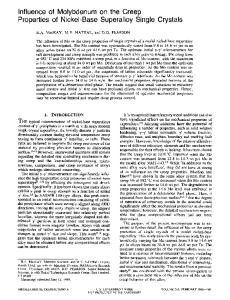Effect of plastic anisotropy on the creep strength of single crystals of a nickel-based superalloy
- PDF / 399,900 Bytes
- 10 Pages / 612 x 792 pts (letter) Page_size
- 29 Downloads / 320 Views
I. INTRODUCTION
THE microstructure of a Ni-based superalloy single crystal consists of a g phase and cuboidal g8 precipitates, whose interfaces are parallel to the {001} planes. The dendrite structure grows in the ^001& direction in the face-centered cubic Ni-based superalloy. This orientation provides better creep strength and a low modulus of elasticity that enhances thermal-fatigue resistance. Thus, the turbine blades are designed so that their primary orientation is within 10 to 15 deg of the ^001& axis to ensure better creep strength and thermal fatigue resistance. The secondary dendrite direction (the ^010& direction) is usually randomly oriented with respect to the longitudinal direction of the turbine blade. The air-cooled turbine blades, which have a complicated hollow structure, are composed of sections of various thicknesses. Therefore, the mechanical properties of each blade section will depend on plastic anisotropy and the stress state as well as on stress in the longitudinal direction. The fatiguecrack growth rate was affected by the plastic anisotropy in the crack tip due to the geometric arrangement of the {111} slip planes.[1] Since a single crystal possesses the intrinsic plastic anisotropy, the strengths of single crystals are influenced by the crystallographic orientations not only in the tensile direction[2,3,4] but also in the normal direction of the specimen.[5] The {111}^112& slip system is the characteristic slip system in the Ni-based superalloy single crystal at intermediate temperatures (973 to 1123 K).[2–4,6–8] Based on the previous study, in the single crystals of an experimental superalloy, it was revealed that {111}^112& slip systems were operative during creep.[6] In this study, by using the single crystals of the experimental superalloy that shows distinct active slip systems, the influence of crystallographic orientations and plastic anisotropy on the creep strength of single crystals of KOJI KAKEHI, Research Associate, is with the Department of Mechanical Engineering, Tokyo Metropolitan University, Tokyo 192-0397, Japan. Manuscript submitted April 19, 1999. METALLURGICAL AND MATERIALS TRANSACTIONS A
the Ni-based superalloy was investigated on the assumption that the {111}^112& and {111}^101& slip systems are activated during creep deformation. II. EXPERIMENTAL PROCEDURES The chemical composition of the Ni-based superalloy is listed in Table I. Single crystals of this alloy were grown from the melt by the modified Bridgman method. After the analysis of the crystallographic orientation by the back-Laue reflection method, the rectangular-cross-sectional specimens and the notched specimens (Figure 1) were cut from the asgrown crystals using a spark cutter. The notched-specimen thickness of 1.0 mm was determined to obtain the planestress condition.[5] The rectangular-cross-sectional specimens had a gage section of 2.7 3 3.0 3 18.5 mm3. The specimens received solution treatment at 1528 K for 36 ks and were then cooled by a blast of air. A single-step aging treatment at 1373 K for 36
Data Loading...











